
© Always Worth Saying 2022, Going Postal
Last time, we followed my father and grandparents in their Ford 8 across the channel and down to the southwest of France via Louviers and Tours, all the way to glamorous Biarritz in the extreme southwest of France.
They stayed at the Hotel Florida, next to the Church of Saint Eugenie which Puffins unfamiliar with the Atlantic Coast resort can use as a landmark in the image above. The church sits slap bang in the middle of the photograph while to its lower left sits the distinctive white edifice of the Bellevue Casino. According to the official Biarritz website,
The first gaming establishment built in Biarritz in 1858, Bellevue Casino was the hub for fashionable society during the Second Empire. Luxury hotels and boutiques crowded around it and for a long time it was the star attraction for Biarritz residents. Destroyed by fire in 1886, it was immediately rebuilt. Once again, there was gambling and dancing according to the epoch, trend and inclination: Charlie Chaplin, Josephine Baker, Jean Patou and even Charles Trenet, all had a weak spot for Biarritz’s vintage casino.
In the modern-day and facing the other direction, we can see the municipal casino or Casino Bierre, on the right.

Biarritz, Pyrénées-Atlantiques: Promenade of La Grande Plage,
W. Bulach – Licence CC BY-SA 4.0
At the end of the Grande Plage beach, where my father took his photo, is the summer palace of Napolean III and Princess Eugenie. A king in all but name, Napoleon III was the un-elected president and Emperor of France from the 1850s until 1870.
It was in 1865 that, on those very sands, the French premier had a cordial stroll with Prussian president Otto von Bismarck during which they casually carved up Europe with difficult consequences for Venetia, Austria, Luxembourg and ultimately for France herself at the hands of the duplicitous German during the Franco-Prussian war half a decade later.
Nowadays, the former royal residence in all but name, is the Hotel du Palais, a five star Hyatt hotel currently being refurbished and due to reopen in June 2022. Rooms start at £500 a night. A grilled tomato in the Michellin starred La Rotonde (appropriate dress code) restaurant will set you back €32.
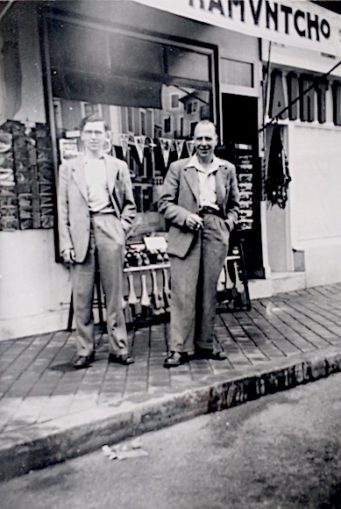
© Always Worth Saying 2022, Going Postal
Away from the great casinos and machinations of the diplomatic Great Game, my father and grandfather are pictured above scouting for contraband outside a postcard, pennant and souvenir store. Although a couple of letters are missing, the shop sign will read ‘Ramuntcho’, a reminder that we aren’t quite in France but in the Basque country which straddles the border between France and Spain.
I should introduce you to my father. Aged 19 in the photograph, he was called ‘Eric’. Regular readers, who’ve previously seen the family tree, will recall my grandparents were Edith and Elihu. One wonders what they did when a letter arrived addressed to E. Worth-Saying? Fought over it, I suppose.
Not sure about the outfits. Given the travelling, continental heat and lack of the likes of tarmac and proper pavements, one is impressed by the shiny shoes. But English gentlemen, even in the boiling heat, tieless? As for the high trousers, baggy despite upturned legs, were they trying too hard to fit in? One does sense a ‘lots of places to hide things’ look to the loose clothing.
For Ramuntcho was a fictitious adventurer and contraband runner featured in a late 19th century Revue de Paris serialisation written by Pierre Lot. According to the blurb, the hero is the bastard son of Franchita (father unknown), who struggled to be an accepted member of Basque society in the village of Etcheza, despite being an accomplished pelota player and smuggler. Gosh.
The dramatised version appeared on the Paris stage in 1910. There have been five film adaptations. In an old copy of The Era I found a review of Rene Barberis’ screen adaptation.
Set in the French side of the Pyrenes the film is notable for exquisite shots of the scenery of that region and for the fine portrayal of Basque types, their pursuit of agriculture and smuggling, and their recreations of song and pelota. A story treated with restraint and allowed to tell itself, with calm simplicity, finely directed by Rene Barberis and beautifully acted.
My relatives weren’t the only unlikely British visitors to Biarritz in 1952. A contemporary edition of the Skegness News reports a Mr W G Gaw and a party of Skegness and Mapleforth residents were received in the Hôtel de Ville after a 2,000 mile trip by luxury coach. At the ceremony, Mlle Jean Pellitier, Croix de Gare, was immortalised in the Skeggy News’s own nostalgia album when pictured accepting a bouquet. During their stay in Biarritz, the good people of the Lincolnshire coastal towns visited the Spanish frontier and the ‘nearby heights of the Pyrenees’. The lame excuse for the excursion was ‘Anglo-French friendship’, however, reading between the lines suggests the friendship extended only as far as a succession of roadside winegrowers’ associations.
Likewise, according to the Bo’ness Journal and Linlithgow Advertiser, a party of four members of the Bo’ness Cycling Club set off on their cycles and, via Bordeaux and Pau, made their way over the hilly countryside to Biarritz the ‘southern rendezvous of the rich holiday maker’. The Advertiser laments that British tourists in Biarritzs were very few that year although many Americans were ‘taking advantage of the sub-tropical playground’ with the cyclists staying for a few days to enjoy well-earned sunbathing, swimming and ‘leisurely time’.
But, bereft of luxury coach or cycles and persisting with an heroic Ford 8, why were my father and grandparents there? Have you guessed yet? All will be revealed. As they drive further into the Basque country we see more of local pursuits and agriculture but firstly, en route, there was a stop-off eight miles away at St Jean de Luz, halfway between Biarritz and Spain.
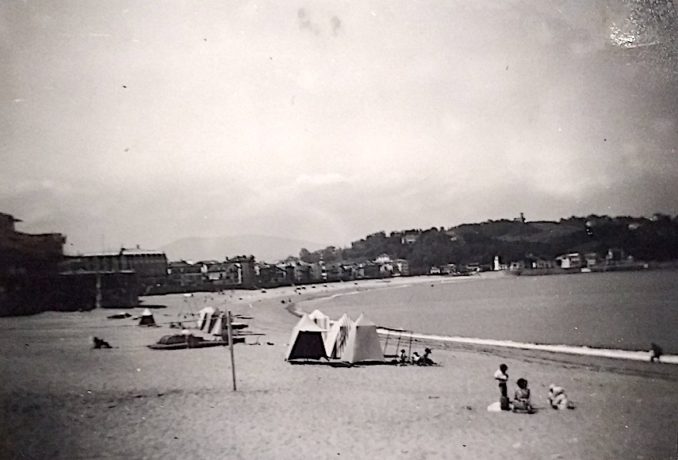
© Always Worth Saying 2022, Going Postal
According to wiki, St Jean de Luz bay is a natural harbour in the southeast of the Bay of Biscay. Protected by strong sea walls and dykes, the excellent beach (a favourite for bathers across the Basque coast) is preserved from the ‘full savagery’ of the Atlantic Ocean. Prior to being a seaside resort, St Jean was a centuries-old port and the venue of the 1660 marriage between French King Louis the XIV and Spanish princess Maria Teresa.
A comparison between the seven decades-old photograph and modern-day Street View shows the hillside in the distance more built up and more wooded. One landmark remains visible – just. More prominent on the horizon in the old photo, and slightly to the right, is a tower and flat-roofed building. In the intervening seventy years, it has become almost obscured, to the casual glance, by windy streets of tile-roofed nouveau riche holiday villas.
At first, I couldn’t locate it in the modern-day. If in doubt, find a Rue de Tour and follow it. Sure enough, a brisk walk to the top of St Jean’s Tower Road reveals the Tour de Bordagain and a neighbouring 15th-century church with its roadside shrine to Our Lady of Bordagain. The church was nationalised in the French Revolution, restored as recently as 2010 and tries somewhat in vain to offer views of the modern-day Saint-Jean-de-Luz Bay and the Basque coast.
As Ramuntcho and the contrabandiers will have headed southwest to the border, so did my father and grandparents. As would Ramuntcho, the Ford 8 passed oxen and mule-led carts. Perhaps amongst the logs and sacks was coffee, chocolate or even radios concealed in anticipation of Franco’s Guardia Nacional?
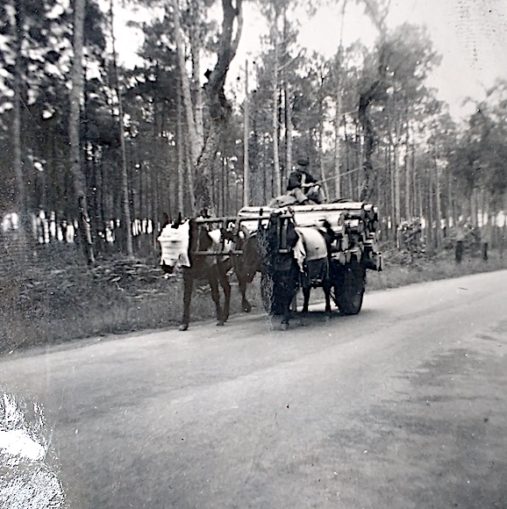
© Always Worth Saying 2022, Going Postal
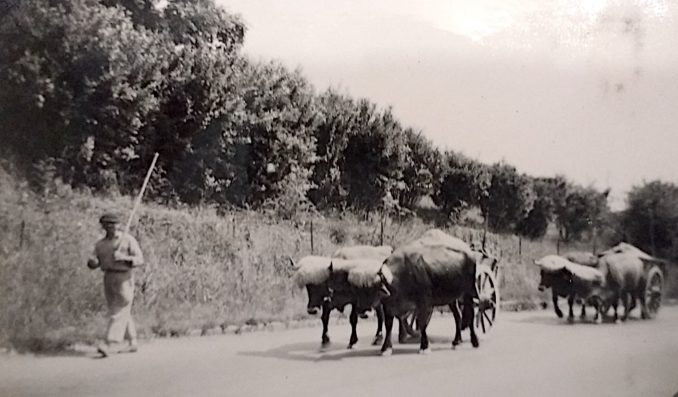
© Always Worth Saying 2022, Going Postal
Note the mules are being led with bags over their heads, presumably fly masks to keep away summer swarms of biting insects. Is the chap leading the oxen with the big stick barefoot? I think he is. In English, that stick is known as a goad where we get our word goading from. The mule driver carries one too.
More particular to the Basque region are the decorative hats upon the oxen. Functional as well as decorative they protect the beast’s heads from the heat of the sun for the same reason the driver wears a cap.
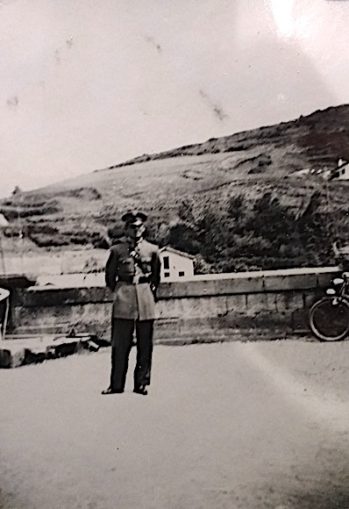
© Always Worth Saying 2022, Going Postal
Continuing the journey, the next photograph is of the Spanish frontier which we will presume to be at the River Bidasoa between the French town of Hendaye and the Spanish settlement of Irun on the opposite bank.
Having stepped into the Generalissimo’s Spain we shall continue our journey next time. Can Puffins tell where they’re going yet? Await the next episode of Nostalgia Album!
© Always Worth Saying 2022



